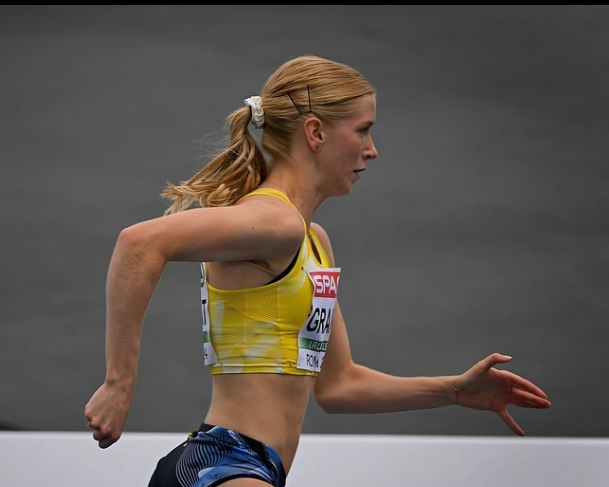Watching Moa Granat cross a hurdle is particularly captivating because of her skillful timing and velocity combination, which demonstrate how meticulously she has honed her craft. Despite the fact that her height is still officially unlisted, her performances continue to provoke discussion among coaches and fans who believe that her success may be influenced by physical attributes intended for hurdle clearance.

Physical structure is important for an athlete who can handle the 400-meter hurdles with such grace. It takes more than practice to master the stride rhythm, knee lift, and clearance over each barrier. They are frequently directed by body-type-related mechanics. According to observers, Granat moves with a fluidity that suggests effective leg length and frame alignment, much like previous Olympic champions. Her height is a subject of conjecture, but it goes beyond simple curiosity. It’s a sincere effort to understand what makes her stride so incredibly fluid.
Moa Granat – Athletic Bio & Personal Highlights
| Attribute | Information |
|---|---|
| Full Name | Moa Granat |
| Date of Birth | August 8, 2004 |
| Age | 20 |
| Nationality | Swedish |
| Sport | Track and Field |
| Specialties | 400m Hurdles, 4x400m Relay |
| Height | Undisclosed |
| Personal Best (400mH) | 55.37 seconds (June 15, 2025) |
| 4x400m Relay Best | 3:29.84 National Record (June 11, 2024) |
| Major Wins | Gold – 2023 European U20 (Jerusalem), Silver – 2021 (Tallinn) |
| Reference | https://www.european-athletics.org |
Moa’s experience competing at the highest level has been especially motivating. She won silver at the European U20 Championships in Tallinn at the age of 17, which significantly raised her profile in the sports world. Two years later, her gold medal in Jerusalem in 2023 solidified her rise from a budding talent to a national treasure. Her consistency is what makes her approach especially novel. Granat races to change rather than to impress.
Not only was her 400-meter hurdles personal best of 55.37 seconds set in June 2025 quick, but it also effectively conveyed the message that she wasn’t there to chase others but rather to carve out her own path. She is among the fastest under-23 runners in Europe at that time, which raises serious concerns about her chances of qualifying for the Olympics.
Her participation in Sweden’s 4×400-meter relay, in which her team set a national record at 3:29.84, was equally outstanding. That race in June 2024 was more than just a statistical high point; it was a demonstration of teamwork carried out with incredibly smooth transitions and supported by her self-assurance under duress. Her ability to read spacing, conserve momentum, and attack curves with unusually sharp focus was especially helpful in that success.
From a cultural standpoint, Moa’s ascent seems to coincide with a more significant shift in Swedish sports. In addition to receiving more attention and sponsorships, female athletes are setting an example. Granat is a notable example of the federation’s growing success as a result of its increased investments in youth development, biomechanics, and mental coaching. Her development is a reflection of a system that has grown up with her.
Granat’s grounded perspective sets her apart from many of her peers. She has every reason to enjoy her early success, but she chooses performance over publicity and stays quietly focused. Granat lets her stopwatch do the talking for her, in contrast to some of her peers who rely on social media for relevance. Ironically, her presence has increased as a result of that silence. Those who are following her path can now clearly see that she is striving for long-term greatness rather than just temporary fame.
Granat shares a remarkably similar competitive ethos with individuals such as Femke Bol and Shamier Little, despite the fact that she may still be developing her global identity. Not only are these athletes quick, but they are also changing the way that people view women’s sports. In those conversations, Granat’s name is slowly mentioned—not because she’s noisy, but rather because she constantly delivers.
A charming contradiction is at work here: Moa Granat comes across as shy and kind in interviews. On the track, however, she is unflinchingly calm and confident. Because of this duality, she is especially interesting to follow. She uses the spotlight of growing celebrity to her advantage, whereas many athletes find it difficult to handle. By doing this, she is changing the definition of early-career excellence in addition to winning more medals.
All indications point to her pace not slowing down in the upcoming years. Her recent gains suggest that she is, at the very least, improving both strategically and physically. Her endurance has increased, her technique has significantly improved, and her competitive IQ is developing. These changes point to a well-organized strategy that might reach its zenith right before important championships.
It’s also important to consider how Granat’s ascent affects how society views female athletes. She is one of the competitors that young girls in Sweden and elsewhere are increasingly looking up to, not only for records but also for representation. She is a prime example of the importance of preparation over show and of process over performance. She is a study in long-form progress in this age of viral moments.
Granat has avoided injuries, which is extremely uncommon in her field, thanks to strategic alliances and careful coaching. In addition to breaking records, the 400-meter hurdles are notorious for breaking bodies. She has developed an athletic foundation that feels incredibly resilient by skillfully navigating training blocks, which has extended her lifespan in a sport that doesn’t readily permit it.
One thing is becoming more and more obvious as concerns about her height continue: whether or not she is physically tall, her ambition and accomplishments are enormous. Every race validates her increasing power, and every medal solidifies her growing clout. Granat appears happy to let fans speculate about her size for the time being as she gradually improves her reputation on the track, where it matters most.
